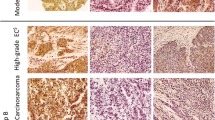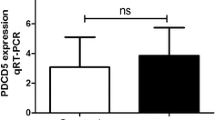Abstract
Background
To evaluate the expression of programmed cell death-ligand 1 (PD-L1) and CD8 in high-grade endometrial carcinomas and relate it to several clinicopathological parameters.
Methods
One hundred and one (101) patients with high-grade endometrial carcinomas who were completely surgically staged were included in this study. PD-L1 and CD8 + expression was evaluated by immunohistochemistry.
Results
In our cohort, 47 women (46.5%) had endometrioid carcinomas and 54 patients (53.5%) were diagnosed with non-endometrioid cancers. In endometrioid carcinomas, there was a significantly higher rate of positivity for PD-L1 expression (p = 0.042) and of intraepithelial CD8 + cell counts (p = 0.004) as opposed to non-endometrioid cancers. There were no significant relationships with any of the other clinicopathological features under study. Univariate and multivariate analysis revealed that only high intraepithelial CD8 + counts (p = 0.01) was associated with longer progression-free survival. Tumors positive for PD-L1 and high intraepithelial CD8 expression were mainly of endometrioid histology, whilst PD-L1-positive/CD8 low and PD-L1-negative/CD8 low tumors were mostly non-endometrioid carcinomas (p = 0.01). PD-L1 negative/CD8 high tumors had the longest progression-free survival (p = 0.032).
Conclusions
In grade 3 endometrial carcinomas, both of endometrioid and non-endometrioid type, high intraepithelial CD8 + counts represent an independent favorable prognostic factor and when related to PD-L1-negative tumors, a longer progression-free survival can be predicted. Immunotherapy could probably be considered for PD-L1-positive/CD8 + high tumors, which were mostly of endometrioid histology.


Similar content being viewed by others
References
Siegel RL, Miller KD, Jemal A (2018) Cancer statistics, 2018. CA Cancer J Clin 68(1):7–30. https://doi.org/10.3322/caac.21442
Miller KD, Siegel RL, Lin CC et al (2016) Cancer treatment and survivorship statistics, 2016. CA Cancer J Clin 66(4):271–289. https://doi.org/10.3322/caac.21349
Bokhman JV (1983) Two pathogenetic types of endometrial carcinoma. Gynecol Oncol 15(1):10–17
Colombo N, Creutzberg C, Amant F et al (2016) ESMO-ESGO-ESTRO consensus conference on endometrial cancer: diagnosis, treatment and follow-up. Ann Oncol 27(1):16–41. https://doi.org/10.1093/annonc/mdv484
Suarez AA, Felix AS, Cohn DE (2017) Bokhman redux: endometrial cancer "types" in the 21st century. Gynecol Oncol 144(2):243–249. https://doi.org/10.1016/j.ygyno.2016.12.010
Piulats JM, Guerra E, Gil-Martin M et al (2017) Molecular approaches for classifying endometrial carcinoma. Gynecol Oncol 145(1):200–207. https://doi.org/10.1016/j.ygyno.2016.12.015
Kondratiev S, Sabo E, Yakirevich E et al (2004) Intratumoral CD8+ T lymphocytes as a prognostic factor of survival in endometrial carcinoma. Clin Cancer Res 10(13):4450–4456. https://doi.org/10.1158/1078-0432.CCR-0732-3
de Jong RA, Boerma A, Boezen HM et al (2012) Loss of HLA class I and mismatch repair protein expression in sporadic endometrioid endometrial carcinomas. Int J Cancer 131(8):1828–1836. https://doi.org/10.1002/ijc.27449
Suemori T, Susumu N, Iwata T et al (2015) Intratumoral CD8+ lymphocyte infiltration as a prognostic factor and its relationship with cyclooxygenase 2 expression and microsatellite instability in endometrial cancer. Int J Gynecol Cancer 25(7):1165–1172. https://doi.org/10.1097/IGC.0000000000000482
de Jong RA, Leffers N, Boezen HM et al (2009) Presence of tumor-infiltrating lymphocytes is an independent prognostic factor in type I and II endometrial cancer. Gynecol Oncol 114(1):105–110. https://doi.org/10.1016/j.ygyno.2009.03.022
Iurchenko NP, Glushchenko NM, Buchynska LG (2014) Comprehensive analysis of intratumoral lymphocytes and FOXP3 expression in tumor cells of endometrial cancer. Exp Oncol 36(4):262–266
Ladanyi A, Somlai B, Gilde K et al (2004) T-cell activation marker expression on tumor-infiltrating lymphocytes as prognostic factor in cutaneous malignant melanoma. Clin Cancer Res 10(2):521–530
Gadducci A, Guerrieri ME (2017) Immune checkpoint inhibitors in gynecological cancers: update of literature and perspectives of clinical research. Anticancer Res 37(11):5955–5965. https://doi.org/10.21873/anticanres.12042
Howitt BE, Shukla SA, Sholl LM et al (2015) Association of polymerase e-mutated and microsatellite-instable endometrial cancers with neoantigen load, number of tumor-infiltrating lymphocytes, and expression of PD-1 and PD-L1. JAMA Oncol 1(9):1319–1323. https://doi.org/10.1001/jamaoncol.2015.2151
Vanderstraeten A, Luyten C, Verbist G et al (2014) Mapping the immunosuppressive environment in uterine tumors: implications for immunotherapy. Cancer Immunol Immunother 63(6):545–557. https://doi.org/10.1007/s00262-014-1537-8
Jones NL, Xiu J, Chatterjee-Paer S et al (2017) Distinct molecular landscapes between endometrioid and nonendometrioid uterine carcinomas. Int J Cancer 140(6):1396–1404. https://doi.org/10.1002/ijc.30537
Liu J, Liu Y, Wang W et al (2015) Expression of immune checkpoint molecules in endometrial carcinoma. Exp Ther Med 10(5):1947–1952. https://doi.org/10.3892/etm.2015.2714
Asaka S, Yen TT, Wang TL et al (2019) T cell-inflamed phenotype and increased Foxp3 expression in infiltrating T-cells of mismatch-repair deficient endometrial cancers. Mod Pathol 32(4):576–584. https://doi.org/10.1038/s41379-018-0172-x
Crumley S, Kurnit K, Hudgens C et al (2019) Identification of a subset of microsatellite-stable endometrial carcinoma with high PD-L1 and CD8+ lymphocytes. Mod Pathol 32(3):396–404. https://doi.org/10.1038/s41379-018-0148-x
Li Z, Joehlin-Price AS, Rhoades J et al (2018) Programmed death ligand 1 expression among 700 consecutive endometrial cancers: strong association with mismatch repair protein deficiency. Int J Gynecol Cancer 28(1):59–68. https://doi.org/10.1097/IGC.0000000000001120
Bregar A, Deshpande A, Grange C et al (2017) Characterization of immune regulatory molecules B7-H4 and PD-L1 in low and high grade endometrial tumors. Gynecol Oncol 145(3):446–452. https://doi.org/10.1016/j.ygyno.2017.03.006
Sungu N, Yildirim M, Desdicioglu R et al (2018) Expression of immunomodulatory molecules PD-1, PD-L1, and PD-L2, and their relationship with clinicopathologic characteristics in endometrial cancer. Int J Gynecol Pathol. https://doi.org/10.1097/PGP.0000000000000543
Tawadros AIF, Khalafalla MMM (2018) Expression of programmed death-ligand 1 and hypoxia-inducible factor-1alpha proteins in endometrial carcinoma. J Cancer Res Ther 14(Supplement):S1063–S1069. https://doi.org/10.4103/0973-1482.202891
Kim J, Kim S, Lee HS et al (2018) Prognostic implication of programmed cell death 1 protein and its ligand expressions in endometrial cancer. Gynecol Oncol 149(2):381–387. https://doi.org/10.1016/j.ygyno.2018.02.013
Yamashita H, Nakayama K, Ishikawa M et al (2018) Microsatellite instability is a biomarker for immune checkpoint inhibitors in endometrial cancer. Oncotarget 9(5):5652–5664. https://doi.org/10.18632/oncotarget.23790
Thallinger C, Fureder T, Preusser M et al (2018) Review of cancer treatment with immune checkpoint inhibitors: current concepts, expectations, limitations and pitfalls. Wien Klin Wochenschr 130(3–4):85–91. https://doi.org/10.1007/s00508-017-1285-9
Mittica G, Ghisoni E, Giannone G et al (2017) Checkpoint inhibitors in endometrial cancer: preclinical rationale and clinical activity. Oncotarget 8(52):90532–90544. https://doi.org/10.18632/oncotarget.20042
US Food and Drug Administration (2017) FDA approves first cancer treatment for any solid tumor with a specific genetic feature. US Food and Drug Administration, Silver Spring
De Felice F, Marchetti C, Tombolini V et al (2019) Immune check-point in endometrial cancer. Int J Clin Oncol. https://doi.org/10.1007/s10147-019-01437-7
Tumeh PC, Harview CL, Yearley JH et al (2014) PD-1 blockade induces responses by inhibiting adaptive immune resistance. Nature 515(7528):568–571. https://doi.org/10.1038/nature13954
Eggink FA, Van Gool IC, Leary A et al (2017) Immunological profiling of molecularly classified high-risk endometrial cancers identifies POLE-mutant and microsatellite unstable carcinomas as candidates for checkpoint inhibition. Oncoimmunology 6(2):e1264565. https://doi.org/10.1080/2162402X.2016.1264565
Ott PA, Bang YJ, Berton-Rigaud D et al (2017) Safety and antitumor activity of pembrolizumab in advanced programmed death ligand 1-positive endometrial cancer: results from the KEYNOTE-028 study. J Clin Oncol 35(22):2535–2541. https://doi.org/10.1200/JCO.2017.72.5952
Kraft S, Fernandez-Figueras MT, Richarz NA et al (2017) PDL1 expression in desmoplastic melanoma is associated with tumor aggressiveness and progression. J Am Acad Dermatol 77(3):534–542. https://doi.org/10.1016/j.jaad.2017.05.007
Teng MW, Ngiow SF, Ribas A et al (2015) Classifying cancers based on T-cell infiltration and PD-L1. Cancer Res 75(11):2139–2145. https://doi.org/10.1158/0008-5472.CAN-15-0255
Husseinzadeh N, Husseinzadeh HD (2014) mTOR inhibitors and their clinical application in cervical, endometrial and ovarian cancers: a critical review. Gynecol Oncol 133(2):375–381. https://doi.org/10.1016/j.ygyno.2014.02.017
Vanneman M, Dranoff G (2012) Combining immunotherapy and targeted therapies in cancer treatment. Nat Rev Cancer 12(4):237–251. https://doi.org/10.1038/nrc3237
Santin AD, Bellone S, Buza N et al (2016) Regression of chemotherapy-resistant polymerase epsilon (POLE) ultra-mutated and MSH6 hyper-mutated endometrial tumors with nivolumab. Clin Cancer Res 22(23):5682–5687. https://doi.org/10.1158/1078-0432.CCR-16-1031
Mehnert JM, Panda A, Zhong H et al (2016) Immune activation and response to pembrolizumab in POLE-mutant endometrial cancer. J Clin Investig 126(6):2334–2340. https://doi.org/10.1172/JCI84940
Garon EB, Rizvi NA, Hui R et al (2015) Pembrolizumab for the treatment of non-small-cell lung cancer. N Engl J Med 372(21):2018–2028. https://doi.org/10.1056/NEJMoa1501824
Sabatier R, Finetti P, Mamessier E et al (2015) Prognostic and predictive value of PDL1 expression in breast cancer. Oncotarget 6(7):5449–5464. https://doi.org/10.18632/oncotarget.3216
Tamura T, Ohira M, Tanaka H et al (2015) Programmed death-1 ligand-1 (PDL1) expression is associated with the prognosis of patients with stage II/III gastric cancer. Anticancer Res 35(10):5369–5376
Mo Z, Liu J, Zhang Q et al (2016) Expression of PD-1, PD-L1 and PD-L2 is associated with differentiation status and histological type of endometrial cancer. Oncol Lett 12(2):944–950. https://doi.org/10.3892/ol.2016.4744
Bellone S, Bignotti E, Lonardi S et al (2017) Polymerase epsilon (POLE) ultra-mutation in uterine tumors correlates with T lymphocyte infiltration and increased resistance to platinum-based chemotherapy in vitro. Gynecol Oncol 144(1):146–152. https://doi.org/10.1016/j.ygyno.2016.11.023
Fridman WH, Pages F, Sautes-Fridman C et al (2012) The immune contexture in human tumours: impact on clinical outcome. Nat Rev Cancer 12(4):298–306. https://doi.org/10.1038/nrc3245
Cermakova P, Melichar B, Tomsova M et al (2014) Prognostic significance of CD3+ tumor-infiltrating lymphocytes in patients with endometrial carcinoma. Anticancer Res 34(10):5555–5561
Hendry S, Salgado R, Gevaert T et al (2017) Assessing tumor-infiltrating lymphocytes in solid tumors: a practical review for pathologists and proposal for a standardized method from the international immuno-oncology biomarkers working group: part 1: assessing the host immune response, TILs in invasive breast carcinoma and ductal carcinoma in situ, metastatic tumor deposits and areas for further research. Adv Anat Pathol 24(5):235–251. https://doi.org/10.1097/PAP.0000000000000162
Thompson ED, Zahurak M, Murphy A et al (2017) Patterns of PD-L1 expression and CD8 T cell infiltration in gastric adenocarcinomas and associated immune stroma. Gut 66(5):794–801. https://doi.org/10.1136/gutjnl-2015-310839
Al-Shibli KI, Donnem T, Al-Saad S et al (2008) Prognostic effect of epithelial and stromal lymphocyte infiltration in non-small cell lung cancer. Clin Cancer Res 14(16):5220–5227. https://doi.org/10.1158/1078-0432.CCR-08-0133
Hendry S, Salgado R, Gevaert T et al (2017) Assessing tumor-infiltrating lymphocytes in solid tumors: a practical review for pathologists and proposal for a standardized method from the international immuno-oncology biomarkers working group: part 2: TILs in melanoma, gastrointestinal tract carcinomas, non-small cell lung carcinoma and mesothelioma, endometrial and ovarian carcinomas, squamous cell carcinoma of the head and neck, genitourinary carcinomas, and primary brain tumors. Adv Anat Pathol 24(6):311–335. https://doi.org/10.1097/PAP.0000000000000161
Jung IK, Kim SS, Suh DS et al (2014) Tumor-infiltration of T-lymphocytes is inversely correlated with clinicopathologic factors in endometrial adenocarcinoma. Obstet Gynecol Sci 57(4):266–273. https://doi.org/10.5468/ogs.2014.57.4.266
Wang Q, Lou W, Di W et al (2017) Prognostic value of tumor PD-L1 expression combined with CD8(+) tumor infiltrating lymphocytes in high grade serous ovarian cancer. Int Immunopharmacol 52:7–14. https://doi.org/10.1016/j.intimp.2017.08.017
Acknowledgements
This research work was supported by the Onassis Foundation—Scholarship ID: G ZO 001-1/2018-2019.
Author information
Authors and Affiliations
Corresponding author
Ethics declarations
Conflict of interest
Onassis Foundation did not influence on the decision to submit this manuscript or on its content. We declare that we have no conflict of interest.
Additional information
Publisher’s Note
Springer Nature remains neutral with regard to jurisdictional claims in published maps and institutional affiliations.
Electronic supplementary material
Below is the link to the electronic supplementary material.
About this article
Cite this article
Vagios, S., Yiannou, P., Giannikaki, E. et al. The impact of programmed cell death-ligand 1 (PD-L1) and CD8 expression in grade 3 endometrial carcinomas. Int J Clin Oncol 24, 1419–1428 (2019). https://doi.org/10.1007/s10147-019-01484-0
Received:
Accepted:
Published:
Issue Date:
DOI: https://doi.org/10.1007/s10147-019-01484-0




